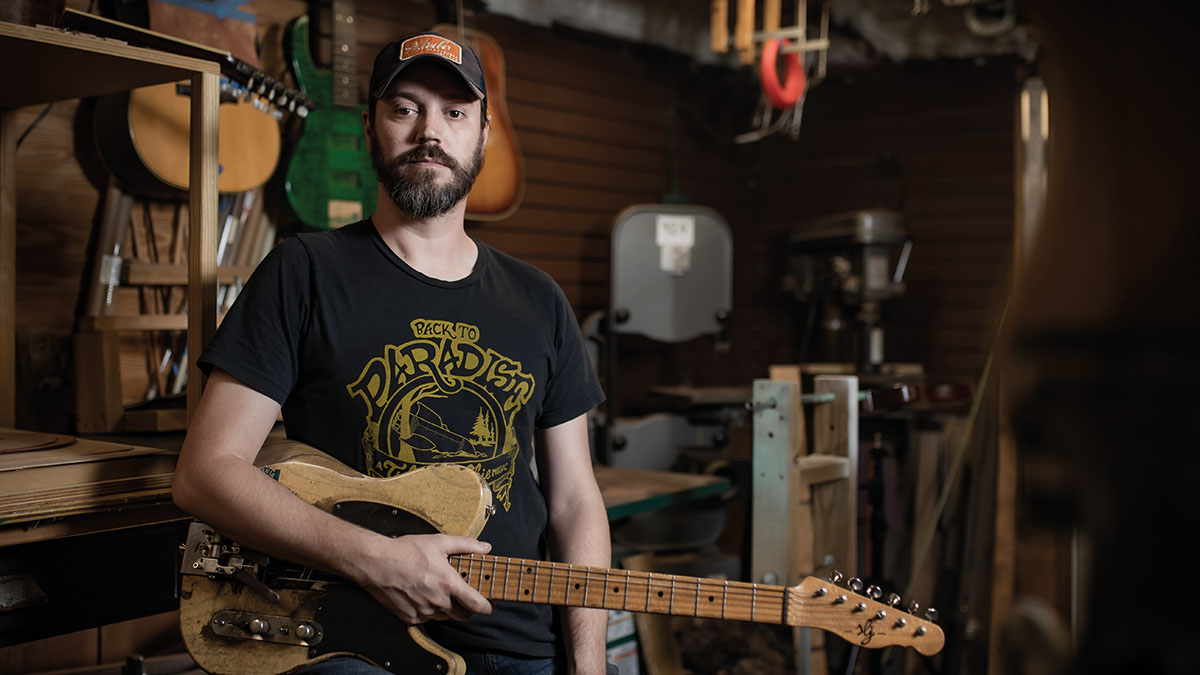Seth Lee Jones on the reinvention of electric blues and why he took guitar building into his own hands
He makes 'em, he plays 'em, and with his Tulsa-based trio, the luthier and slide-guitar whiz is looking to extend the catalog of blues standards

Seth Lee Jones knows the world doesn’t need another take on Born Under a Bad Sign. Ditto with The Thrill Is Gone, Crossroads or Little Red Rooster. Great songs, all: a tune doesn’t become known as a standard for nothing.
The problem with blues standards, though, is they get covered and re-interpreted over and over, to the point there’s no fresh take to be offered. Odds are, the Rolling Stones would’ve beat you to it by half a century. That’s why the Tulsa-bred singer and guitarist dipped deep into the well for Flathead, the debut studio album by his eponymous trio.
“I feel like somebody should put together a list of the top 10 blues songs you should never play,” Jones says with a laugh. “We kind of just picked our favorites. I run a democratic ship in my band. We just picked the ones we like the best amongst the three of us.”
The nine tracks that made it onto the album aren’t all totally obscure – familiar names like Muddy Waters, Johnny Winter and Howlin’ Wolf are represented. It’s the kind of setlist that would be put together by a band that’s put in the hours, learning how to give blues aficionados what they want through years of gigging. Which is exactly what the trio is: they’ve spent years as a house band at Tulsa’s popular venue The Colony.
Given the sheer number of gigs under their collective belt, it made sense to record Flathead the old-fashioned way: set up the instruments and bash ’em out live on the floor. Total number of hours spent in the studio recording: seven and a half. “I just like working that way. I’ve got buddies who will spend months on records. You drive those so many times a week for so many years, it becomes like autopilot.”
If the goal was to capture the raw, dirty and intimate vibe of a well-worn band doing their thing in front of a booze-soaked crowd, Seth Lee Jones and his crew succeeded wildly on Flathead, with Jones’ gritty vocals and sleazy, overdriven open-D tuned slide playing capturing most of the attention (though much credit should also go to bassist Bo Hallford and drummer Matt Teegarden, whose father David not only owns the studio in which the record was made, but is also an accomplished sideman to guys like Bob Seger and Eric Clapton).
Making the album quickly wasn’t just a means to an end; it was also something of a necessity. The sidemen have their own projects going on and Jones is a bit busy with his own day job: he’s the proprietor of SLJ Guitars, a boutique shop that produces high-end, one-of-a-kind instruments and does the type of tough restorations on vintage guitars that’d give most big-box guitar store employees some very weak knees.
Get The Pick Newsletter
All the latest guitar news, interviews, lessons, reviews, deals and more, direct to your inbox!
Among the pieces he’s built is the Tele-type that’s played throughout Flathead. Built during his starving luthier days in Venice Beach, it’s the result of a lot of experimenting and some happy accidents, resulting in an axe with benders built into the A, G and B strings.
“I was putting that guitar together because I wanted to learn some B-bender licks, like Brad Paisley licks, but I couldn’t afford one of those benders like he has. It would have been $1,200 or something.
“The original neck I built for that was completely backwards and I couldn’t get it to straighten out. I’ve been playing lap steel since I was a teenager; what I did was put the biggest set of strings I could find on it and started playing slide on it. I started pushing on that level when it was tuned to open D and found I could go from a I chord to a IV chord if I push the bottom two levers at the same time. It was like, ‘Oh, this is actually cool!”
The guitar does feature some strings that would be a hand-killer for conventional bends: a set of .12s, but the high E and B are swapped out for 17s. Wacky strings and bending contraptions aside, there are other modifications.
“I’ve modified it to work with that tuning. I’ve got the base plates cut a little bit on the bottom side to extend the range on the A string and then I’ve got handles that are custom made to make it more ergonomic for your hand to sit on it. It’s not adjustable, too. That neck has got no truss rod in it, just a carbon fiber bar.”
Like the blues, electric guitar building is an art that’s best learned at the knees of the masters. During a stint in Los Angeles, Jones found himself working for noted luthier John Carruthers and picked up tips from guys like Ron Thorn (now of the Fender Custom Shop). With his hard-won knowledge, Jones returned to Tulsa in 2010.
“I started building on the side back in 2008 but I didn’t get the time to do it until I moved back here. It’s just really expensive to live in Los Angeles, and the cost of living here is incredibly low, so I have a lot more time to focus on my art.”
After over a decade in business, he’s now making between 25 and 30 guitars per year, from the truss rods to the bodies to even the dots. He even used to make his own pickups but explains that he “stopped doing that because there’s way too many guys who are just killing that game.”
Between his band and his shop, Jones has found himself in an interesting spot: playing tight blues takes commitment, but so does building high-quality gear. At the end of the day, burning down a club gig can’t compete with the need to pay the bills, which sounds like a pretty good basis for a blues song.
“Unfortunately, there’s a bit of a squeaky wheel thing that happens, where it’s like what needs to get out first, as far as who’s complaining,” he says. “I can’t really be away from the shop for more than five to 10 days. Because there’s a lot of work that gets done, and that keeps my lights on. As far as music goes, I generally make tens of dollars playing, but I love doing it.”
- Flathead is out now via Horton Records.
Adam is a freelance writer whose work has appeared, aside from Guitar World, in Rolling Stone, Playboy, Esquire and VICE. He spent many years in bands you've never heard of before deciding to leave behind the financial uncertainty of rock'n roll for the lucrative life of journalism. He still finds time to recreate his dreams of stardom in his pop-punk tribute band, Finding Emo.
“I suppose I felt that I deserved it for the amount of seriousness that I’d put into it. My head was huge!” “Clapton is God” graffiti made him a guitar legend when he was barely 20 – he says he was far from uncomfortable with the adulation at the time
“I was in a frenzy about it being trapped and burnt up. I knew I'd never be able to replace it”: After being pulled from the wreckage of a car crash, John Sykes ran back to his burning vehicle to save his beloved '76 Les Paul










